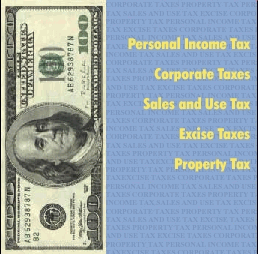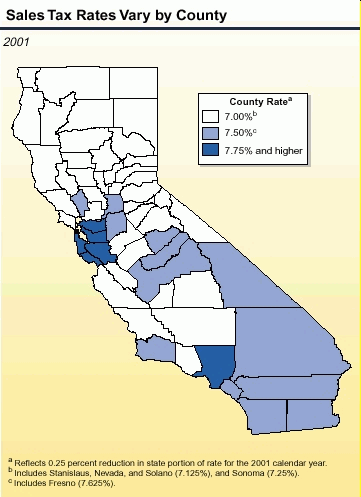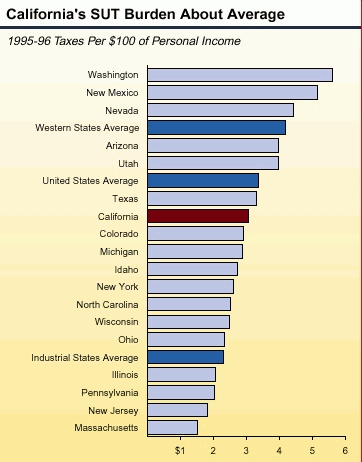
 |
California's Tax SystemA PrimerChapter 3 |
The sales and use tax (SUT) is the second largest tax levied in California and is assessed at both the state and local levels. California is one of 45 states that levy a SUT with only Alaska, Delaware, Montana, New Hampshire, and Oregon not levying one. California's state-level SUT was established in the 1930s and its local SUT emerged in 1955. In 1999-00, California SUT revenues totaled about $32�billion, with about 75�percent going to the state and 25�percent to localities.

California's SUT has two distinct components--the sales tax and the use tax.
The SUT is a tax on final sales of tangible personal property, such as clothing, household furnishings, appliances, and motor vehicles. Intermediate sales of goods (say, from a wholesaler to a retailer) are not taxed and, in addition, certain individual items are specifically exempted from the SUT. The largest of these tax expenditure programs (TEPs) involve utilities and home-consumed food. Services are largely exempt from taxation, although California does tax a few. Services are indirectly taxed, however, to the extent that their cost is incorporated into the final prices of tangible goods. For those states that directly levy a SUT on services, over half tax cleaning services, for example, while only six (Hawaii, Connecticut, Iowa, New Mexico, South Dakota, and Washington) tax professional and personal services.
| Largest SUT Tax Expenditure Programs | |||
| 1998-99
(In Millions) | |||
| Exclusion/Exemption | Revenue Reduction | ||
| State | Local | Total | |
| Gas, electricity, water, steam, and heat | $2,482 | $782 | $3,264 |
| Food products | 2,052 | 646 | 2,698 |
| Prescription medicines | 539 | 170 | 709 |
| Custom computer programs | 210 | 66 | 276 |
| Candy, gum, and confectionery products | 165 | 52 | 217 |
| Animal feed | 157 | 50 | 207 |
| Bottled water | 71 | 22 | 93 |
| Free newspapers and periodicals | 56 | 18 | 74 |
The SUT rates in California differ by county, and range from 7�percent to 8.25�percent, depending on whether a county chooses to levy optional taxes.
As of January 1, 2001, the average statewide SUT rate was 7.67�percent (weighted by sales). This includes:

Local SUT LeviesThe sales and use tax (SUT) comprises on average about one-third of general purpose city tax revenues and 6�percent of county tax revenues and, thus, is a major local revenue source. Uniform Local SUT. The 1.25�percent Bradley Burns Uniform Local Sales and Use Tax is allocated to cities and counties as follows (1) 0.25�percent to the county in which a sale occurs to fund transportation projects, and (2) 1�percent for general purposes to the city in which the sale occurs, or the county if the sale was in an unincorporated area. Special district taxes are allocated to the appropriate local district. Optional Local SUT. Regarding the optional SUTs that localities can levy, these average 0.67�percent on a statewide basis, and are levied in 24 of California's 58 counties. They can be adopted by counties, cities, or special taxing jurisdictions or districts. The latter are formed to fund local programs such as transportation projects, hospital services, public libraries, and schools. California's 58 counties, 475 cities, and 35 special tax districts have a plethora of individual SUT levies that makes administering and allocating their revenues challenging. These optional SUTs require two-thirds voter approval if the revenues are to be dedicated to a specific purpose. A majority vote is required for an additional general purpose local sales tax. Statewide, these optional taxes currently range from 0.125�percent to 1.25�percent. |
Compared to other western states and the large industrial states, California has a relatively high SUT rate--exceeded only by Washington and Illinois. However, because it also has many SUT exemptions and exclusions, its SUT revenues per $100 of personal income ($3.06 in 1995-96) are slightly below the national average and significantly below the western states' average.
California's SUT revenues have increased at a healthy rate over the last few years; in 1998-99, for example, revenues increased by almost 9�percent. However, the tax performed poorly during the first half of the 1990s, and has represented a declining share of personal income over the last 20�years. This is due to changes in both consumption patterns and the structure of the economy, and raises questions as to its future performance.

The basic structure of the SUT has been a topic of increased attention and concern for many years, especially in recent decades as the economy and California's fiscal landscape have experienced change. Key SUT-related issues include:
Tax Policy and the InternetThe rapid development of Internet commerce has raised a number of important issues regarding state taxes and, in particular, the future of the state and local sales and use tax (SUT). The concerns relate both to the fairness of the tax as well as potential revenue effects on states and localities. Tax Fairness. The issue of tax fairness exists because retail businesses with a physical presence in California must collect the SUT from purchasers, while businesses operating over the Internet (or other remote means) and with no physical presence in the state cannot be required to collect the tax. Some businesses argue that this is unfair because it creates a tax-generated bias toward remote sellers. Other businesses claim that it would be unfair for businesses with no physical presence in a state to be required to collect taxes. Revenue Effects. Possible revenue effects on state and local governments is of concern due to two particular features of Internet commerce. First, if Internet commerce grows at the expense of growth in sales by traditional "main street" businesses, the SUT base will continue to decline, which could have a direct impact on state and local revenues. Second, Internet technology is capable of transforming numerous tangible goods into a nontangible form. These would then not be part of the SUT base, and would result in state and local revenue losses. Internet commerce tax issues and suggested approaches for addressing these issues are discussed in the LAO publication, California Tax Policy and the Internet, January,�2000. |
Return to California's Tax System--A Primer Table of Contents